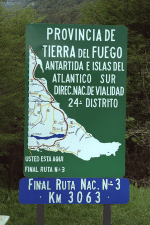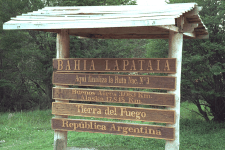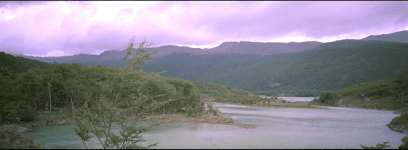Lapataia Bay, Tierra del Fuego
January 29, 1994
Paola also told us about the Yamana (pronounced
something like "Hurmaynuh"), the
native tribes of this area which were here up to 6,000 years before the
Europeans came. They lived without clothes, using animal fats to oil their
bodies and always having a fire nearby, even on their canoes, which they
lived on in a nomadic fashion.
Some of the indians had tents on the hills surrounding Lapataia Bay, and we
can still see the pole holes they left behind, as well as the circular raised
rings around each tent site which were created over a period of years by
their garbage (shells, bones, etc.). It looks like a series of raised rings
all over the hilltops, with pole holes around the inner edges of each ring.
These are surely still being studied for archaeological evidence.
At Lapataia Bay, just before these hilltops and the catamaran landing, we
found the very end of Argentina's National Route 3, which starts in
Buenos Aries, over 6,000 miles away.


Signs at the end of the road

Lapataia Bay, Tierra del Fuego
Side notes
A special thanks at this point to Sergio Juri, an IBM employee originally from
Argentina, who gave me the correct spelling for the Yamana indian tribes, and
who corrected my reference to National Route 3. Sergio also gave me a
reference to "Lancha Packewaia, Antropologia de los Canales Fueguinos", which
he refers to as "a very nice book of the region [sic] anthropology."
Thanks Sergio!
You can take a catamaran ride on the Beagle
Channel, or return to today's table of
contents.

